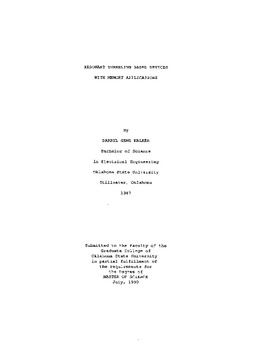| dc.contributor.author | Walker, Darryl Gene | |
| dc.date.accessioned | 2014-12-17T20:26:58Z | |
| dc.date.available | 2014-12-17T20:26:58Z | |
| dc.date.issued | 1990-07-01 | |
| dc.identifier.uri | https://hdl.handle.net/11244/14027 | |
| dc.description.abstract | As integrated circuit technology approaches its theoretical limits in Bipolar Junction and MOS device density, the ability to achieve greater circuit density can only be obtained by the developement of new electronic devices. The limits of present Bipolar Junction and MOS devices are due to the domination of quantum mechanical effects as the device dimensions become smaller thus preventing the device from operating in the manner for which it was designed. It is only natural that a device that operates on the basis of quantum effects would be the choice for denser circuitry. A quantum mechanical effect that can be used to make devices of interest is electron tunneling of which resonant tunneling is a special phenomena that exists in certain structures in which tunneling exists. Resonant tunneling is of special interest due to a region of negative differential resistance (NDR) in the current-voltage characteristics which will be shown in Chap. 2. This NDR makes a resonant tunneling device useful in a number of applications including: high frequency oscillators, multi leveled logic, analog to digital converters, infrared laser amplifiers, infrared optical detectors, and memory cells. In chapter II the physics of a double barrier resonant tunneling diode (RTD) is dicussed. The transmission coefficient is derived and the current-voltage characteristics of a double barrier RTD are discussed. Some design considerations for the RTD along with the material used to build these devices are discussed. In chapter III resonant tunneling devices are reviewed. Switching limits and frequency limits of resonant tunneling diodes are also discussed. In chapter IV a SPICE model for a resonant tunneling diode is presented and a new resonant tunneling diode memory cell is presented and analyzed. Finally in chapter V conclusions are drawn about the memory structure presented and suggestions for further research are made. | |
| dc.format | application/pdf | |
| dc.language | en_US | |
| dc.publisher | Oklahoma State University | |
| dc.rights | Copyright is held by the author who has granted the Oklahoma State University Library the non-exclusive right to share this material in its institutional repository. Contact Digital Library Services at lib-dls@okstate.edu or 405-744-9161 for the permission policy on the use, reproduction or distribution of this material. | |
| dc.title | Resonant Tunneling Based Devices with Memory Applications� | |
| dc.type | text | |
| osu.filename | Thesis-1990-W178r.pdf | |
| osu.accesstype | Open Access | |
| dc.description.department | Electrical Engineering | |
| dc.type.genre | Thesis | |
